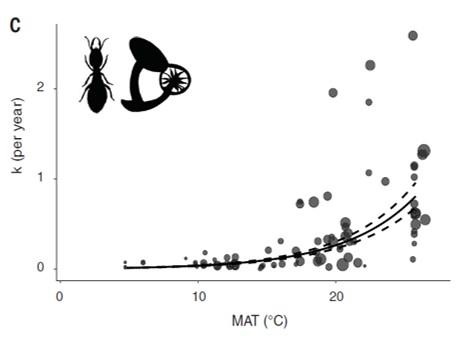Amy E. Zanne, Habacuc Flores-Moreno; Jeff R. Powell; William K. Cornwell; James W. Dalling; Amy T. Austin; R. Aragón; R. Fernandez et al. 2022.
SCIENCE, 37(6613): 1440-1444. DOI: 10.1126/science.abo3856
Termites are often thought of as pests, munching away at the foundations of homes and buildings. In tropical forests, these master wood carvers are important decomposers, but are much less studied than micro-organisms. An understanding of their climate sensitivities is needed to estimate climate change effects on wood carbon pools. Using data from 133 sites spanning six continents, we found that termite wood discovery and consumption were highly sensitive to temperature. The rate of termite wood decomposition and consumption increases more than 6.8 times with every 10°C increase in temperature. In comparison, microbial wood decay only doubles under the same rise in temperature.
Precipitation did not affect termite wood decay but termites finding wood (discovery) is temperature and precipitation sensitive. Termite discovery is higher in warm and dry places, thus termites elevated wood decay most in tropical savannas, tropical seasonal forests and subtropical deserts. While the termite decay was expectedly the greatest in tropical environments, we found they had a noticeable effect on decomposition in drier places like tropical savannahs and subtropical deserts. When we combined our termite discovery-climate sensitivity relationships with different mid-century climate change scenario projections, termites are expected to expand out of the tropics increasing carbon- cycling rates globally and hence, changing C pools.

Study site distribution across mean annual temperatures (MATs), mean annual precipitations (MAPs), and Whittaker biomes (panels A&B). Decay rate (k) estimates across Whittaker biomes (panel C).

Decay rates of termite discovered wood across MAT
DOI: 10.1126/science.abo3856